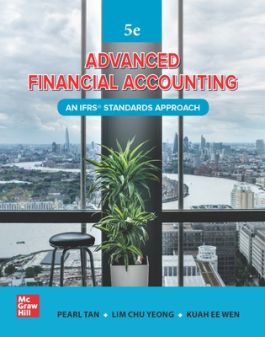Advanced Financial Accounting, Fifth Edition
- Access the eBook anytime, anywhere: online or offline
- Create notes, flashcards and make annotations while you study
- Full searchable content: quickly find the answers you are looking for
Preface
Chapter 1. Risk Reporting
Chapter 2. Group Reporting I: Concepts and Context
Chapter 3. Group Reporting II: Application of the Acquisition Method under IFRS 3
Chapter 4. Group Reporting III: Accounting for Business Combinations and Non-controlling Interests under IFRS 3 in Post-acquisition Periods
Chapter 5. Group Reporting IV: Consolidation under IFRS 10
Chapter 6. Group Reporting V: Equity Accounting under IAS 28 Joint Arrangements under IFRS 11
Chapter 7. Group Reporting VI: Complex Consolidation Issues
Chapter 8. Accounting for the Effects of Changes in Foreign Exchange Rates
Chapter 9. Financial Instruments: Classification, Recognition, and Measurement
Chapter 10. Accounting for Derivatives and Hedge Accounting
Chapter 11. Accounting for Taxes on Income
Chapter 12. Earnings per Share
Chapter 13. Share-based Payment
Chapter 14. Special Issues: Common Control
Chapter 15. Derivative Contracts on Own Equity
Advanced Financial Accounting (5e), with its step-by-step explanations and illustrations of the application of complex accounting standards, enables aspiring accountants in today’s dynamic accounting environment to develop expertise with insight. The book is a suitable text for both undergraduate and postgraduate accounting students in universities and candidates sitting for professional accounting examinations. It also serves as a useful reference for accounting practitioners who are keen to stay updated with the IFRS® Standards and IAS® Standards that are featured in this text. It presents the accounting issues clearly, illustrates the application of the IFRS® Standards and IAS® Standards systematically and explains the processes thoroughly. As accounting standards become more comprehensive and economic transactions become more complex, it is necessary for accounting professors to equip their students with the tools and knowledge to address these challenges confidently.
This new edition builds upon the success of the previous four editions through its emphasis on explanations and illustrative examples to help students understand complex accounting requirements that deal with advanced level accounting topics. These topics include group reporting, accounting for the effects of foreign exchange rates, financial instruments, hedge accounting, share-based payments, earnings per share and deferred tax among others. The book deals with the complexity of accounting issues head on and explains integrated problems that involve the application of more than one IFRS® Standard and IAS® Standard. There are new end-of-chapter questions, impactful diagrams, flowcharts, concept maps and many other features as explained in the Preface of this book.
NEW FEATURES
New content and expanded coverage include the following:
- A real-life example of the application of the acquisition method
- New explanatory content on complex scenarios involving transfers at a loss
- Enhanced explanations and illustrations on business combinations, consolidation and changes in ownership interests
- In-depth explanations and detailed illustrations on the preparation of consolidated cash flow statements, including treatment of foreign currency effects
- Enhanced explanations on financial instruments under IFRS 9, including common approaches of measuring expected credit losses and interest rate benchmark reforms
- Application of IFRIC 22 Foreign Currency Transactions and Advance Consideration
- Accounting for deferred tax on assets and liabilities arising from single transactions, such as IFRS 16 Leases
- Expanded explanations and detailed examples on modifications and cancellations of share-based payments transactions
- Enhanced explanations and worked examples on intragroup transactions between a parent and a foreign subsidiary
- New end-of-chapter questions, as well as new and expanded illustrations and explanations across chapters
- Many other features, as explained in the Preface



